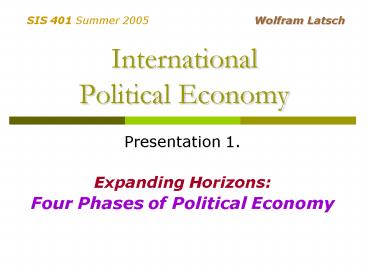International Political Economy - PowerPoint PPT Presentation
1 / 19
Title:
International Political Economy
Description:
Reciprocity, 'reciprocal altruism' (tit-for-tat) Division of rewards, rejection of ... Cooperation, punishment of cheats (free riders) 'Respect of possession' ... – PowerPoint PPT presentation
Number of Views:67
Avg rating:3.0/5.0
Title: International Political Economy
1
International Political Economy
SIS 401 Summer 2005
Wolfram Latsch
- Presentation 1.
- Expanding Horizons
- Four Phases of Political Economy
2
Four Phases of Political Economy
- Non-human primates
- Human foraging
- Sedentary agriculture
- Industrial society
20-12 m.y.a.
100,000 y.a.
Anatomically modern humans H. sapiens sapiens
10,000 y.a.
250 y.a.
3
Four Phases of Political Economy
- Non-human primates (monkeys, apes)
- Evolution of human behavioral traits
- Reciprocity, reciprocal altruism (tit-for-tat)
- Division of rewards, rejection of unfair offers,
- inequity aversion
- Balancing of individual and group interest
4
Four Phases of Political Economy
- Non-human primates (monkeys, apes)
- Evolution of human behavioral traits
- Coalition-building, short-term and long-term
relationships - Marketplace of services
(grooming, sex, food, babysitting, support in
fights) - Cooperation, punishment of cheats (free riders)
- Respect of possession
5
Four Phases of Political Economy
Earliest anatomically modern human, Ethiopia, c.
160,000 y.a.
6
Four Phases of Political Economy
- Human foraging (hunting and gathering)
- Mobile bands
- Small groups (lt100)
- Low degree of economic and political
specialization - Limited status differences, low inequality
- Egalitarian division
- Few private possessions or personal property
- Low fertility
7
Four Phases of Political Economy
The Fertile Crescent Birthplace of Agriculture
and Urban Society
8
Four Phases of Political Economy
- Sedentary agriculture (farming)
- Domestication of plants and animals
- Selective breeding
- Hybridization
9
Factors Underlying the Broadest Pattern of History
- Ultimate Factors
- Suitable Ease of
- wild species Spreading
- Domesticated species
- Food surpluses/storage
- Large, dense, sedentary, stratified societies
- Technology
- Steel Increase in Social
Complexity - Ships
- ..
- Diamond (1997) 87
Proximate Factors
10
Four Phases of Political Economy
- Sedentary agriculture (farming)
- Domestication of plants and animals
- Extensive growth (Lucas)
- Intensification of subsistence agriculture
- Decrease in ambiguity of possession (esp. land,
livestock, animal products, stores, treasure) - Increase in private possessions, esp. land
- (the first property rights revolution)
11
Four Phases of Political Economy
- Sedentary agriculture (farming)
- Increases in inequality
- Increase in group size
- Increase in economic and political specialization
- Emergence of the state as specialists in
violence (exclusive state) - Emergence of the state as manager of works and
projects (e.g. irrigation, monuments)
12
Four Phases of Political Economy
- Sedentary agriculture (farming)
- Increase in social stratification (two classes,
owners and non-owners, based on access to land) - Owners of land low fertility
- Non-owners (tenants, peasants) high fertility
- Beginnings of urbanization
- Achievements of civilization available to few
- Accumulation of human capital derived from land
wealth
13
Four Phases of Political Economy
- Sedentary agriculture (farming)
- The exclusive state
- Political markets Access to political power is
limited - Economic markets The state limits access to
markets for goods and services, limits
competition in return for support - Property rights The state limits protection of
PRs to a small group of supporters (owners) - Non-owners are kept close to subsistence
14
Four Phases of Political Economy
15
Four Phases of Political Economy
- Industrial society (manufacturing, services,
ideas) - Increasing role of capital and investment
- Intensive growth (sustained growth in per
capita real incomes) - Increasing role of useful knowledge (scientific
revolution) - Spread of factories, wage labor
- Use of fossil fuels (coal, oil)
16
Four Phases of Political Economy
- Industrial society (manufacturing, services,
ideas) - Growth of literacy and education (human
capital, HK), HK network externalities, ?
in returns to HK - Changes in the role of children (quality v.
quantity, fertility reductions) - Changes in social structure emergence of the
middle class, importance of non-land assets - Merchants, traders, bankers
- Craftsmen
- Scholars
17
Four Phases of Political Economy
- Industrial society (manufacturing, services,
ideas) - Spread of competitive markets
- Growth of international trade
- Spread of ownership, changes in concepts of
ownership (e.g. intellectual property) - A more open access political regime (inclusive
state)
18
Four Phases of Political Economy
- Industrial society (manufacturing, services,
ideas) - The inclusive state
- Political markets Access to political power is
broadened (franchise) - Economic markets The state widens access to
markets for goods and services, markets become
more competitive - Property rights The state expands protection of
PRs, broadening of PRs - Ownership expands
- (labor power, intellectual property, human
capital etc.)
19
Key terms
- Property, property rights, control rights
- Specialization, division of labor
- Exchange
- Reciprocity, reciprocal altruism
- Extensive growth and intensive growth
- Networks, network externalities
- Human capital, middle class































